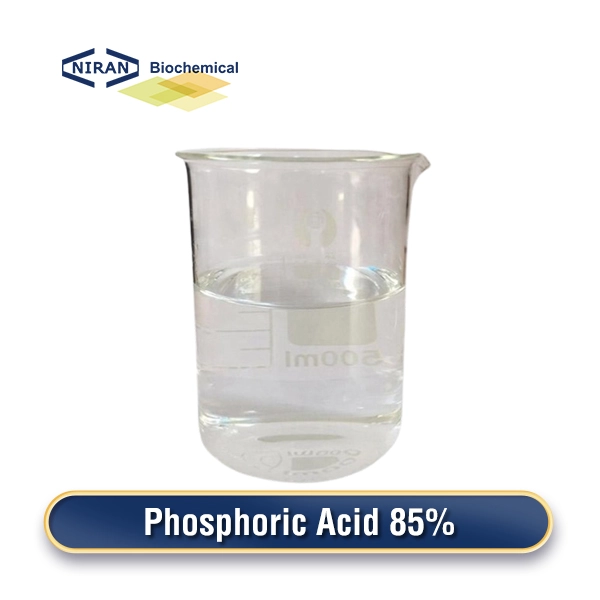Phosphoric acid is a common food additive, known for its ability to enhance flavor, preserve freshness, and improve the texture of various food products. It plays a significant role in the food processing industry, particularly in beverages, dairy products, and processed foods. As one of the most widely used acids in food manufacturing, it is essential for both its functional and preservative qualities. This article explores the key uses of phosphoric acid in food processing, its benefits, and how it contributes to food quality and shelf life.
What is Phosphoric Acid?
Phosphoric acid (H₃PO₄) is a colorless, odorless, and highly acidic compound commonly derived from natural sources like phosphate rocks or produced synthetically for industrial use. It is often used as a food additive to adjust pH levels, enhance flavors, and act as a preservative. As one of the most widely approved acids, phosphoric acid is recognized by global food safety authorities, including the FDA, for its safe application in food processing when used within established guidelines.
Enhancing Flavor in Beverages
Phosphoric acid is particularly known for its role in soft drink manufacturing, where it serves to provide a sharp, tangy taste. One of the most notable applications is in cola beverages, where phosphoric acid adds to the characteristic flavor profile. By lowering the pH of the drink, it balances the sweetness of the sugar or high-fructose corn syrup, creating a more refreshing and complex taste. Phosphoric acid can also help in flavor development in other carbonated beverages like fruit drinks, providing a well-rounded tartness that complements the sweetness of added fruit concentrates.
Beyond beverages, phosphoric acid can also be used in food flavoring to mimic the natural acidity found in ingredients like citrus fruits or certain fermented foods. For example, in sauces and condiments, phosphoric acid can enhance the tanginess, making the product more appealing and flavorful.
Preserving Freshness and Extending Shelf Life
One of the primary functions of phosphoric acid in food processing is its ability to preserve freshness and extend the shelf life of food products. Phosphoric acid acts as a preservative by lowering the pH of the food, creating an acidic environment that inhibits the growth of spoilage microorganisms such as bacteria, molds, and yeasts. This function is particularly valuable in the preservation of beverages, canned goods, and ready-to-eat meals, ensuring that products remain safe and consumable for a longer period.
In processed meats, dairy products, and baked goods, phosphoric acid helps maintain the freshness of the product by slowing down the oxidation process. This reduces the likelihood of rancidity and maintains the flavor profile for a longer time, allowing manufacturers to distribute their products over larger distances or store them in warehouses without the immediate risk of spoilage.
Improving Texture and Consistency
Phosphoric acid is also used to adjust the texture and consistency of certain food products. In dairy processing, it is employed to enhance the texture of cheeses and other dairy products by influencing protein interactions. Phosphoric acid helps maintain the desired firmness and smoothness, ensuring that products like cheese and yogurt maintain their texture during storage and handling.
In addition, phosphoric acid can work in conjunction with other food additives, such as xanthan gum, to improve the viscosity and stability of liquid or semi-liquid foods. xanthan gum suppliers provide this versatile hydrocolloid, which helps stabilize emulsions and suspensions, improving the mouthfeel and consistency of sauces, dressings, and soups. When combined with phosphoric acid, xanthan gum can help to thicken and stabilize the product, ensuring that it remains smooth and appealing to the consumer.
Synergy with Other Additives
Phosphoric acid does not work in isolation; it is often used in combination with other ingredients to achieve the desired texture, flavor, and stability in food products. For example, when used with preservatives like sodium benzoate or citric acid, phosphoric acid helps to improve the overall efficacy of the preservation process. In beverages, phosphoric acid might be combined with caffeine or other flavorings to create a more balanced and consistent product.
Xanthan gum suppliers provide another key ingredient often used in conjunction with phosphoric acid, especially in beverages, dressings, and sauces. Xanthan gum’s ability to improve viscosity and stabilize emulsions enhances the effects of phosphoric acid, ensuring that the product has a smooth texture and uniform consistency from production to consumption.
Conclusion
Phosphoric acid is a crucial ingredient in the food processing industry, offering benefits that extend from flavor enhancement to preservation. Whether it’s in soft drinks, dairy products, or processed foods, this versatile acid plays an integral role in ensuring food quality and safety. Its ability to enhance flavor, preserve freshness, and improve texture makes it indispensable in food manufacturing. When paired with other additives, such as xanthan gum, it can help manufacturers achieve the perfect product texture and stability. As phosphoric acid continues to be widely used across various food categories, food producers and Phosphoric acid suppliers will remain essential partners in ensuring the highest standards of quality and innovation in the industry.

